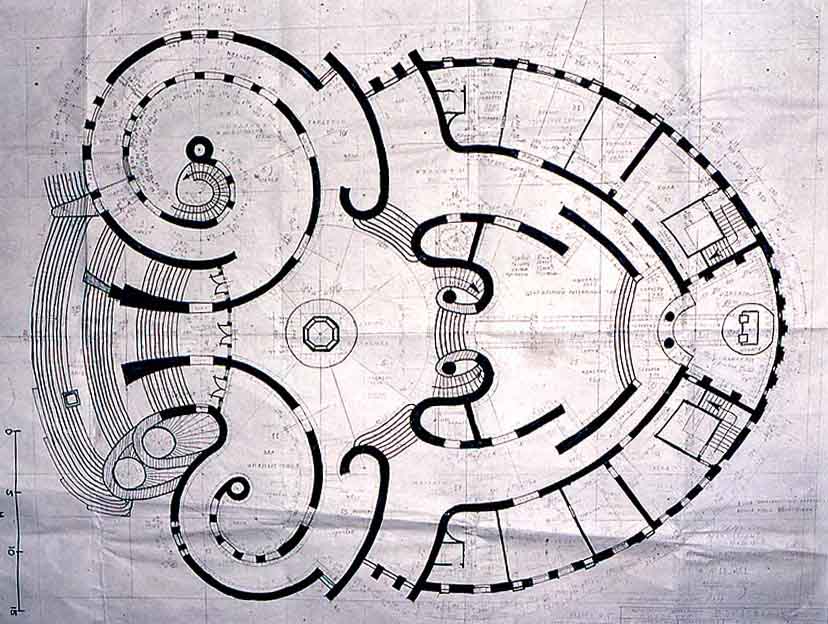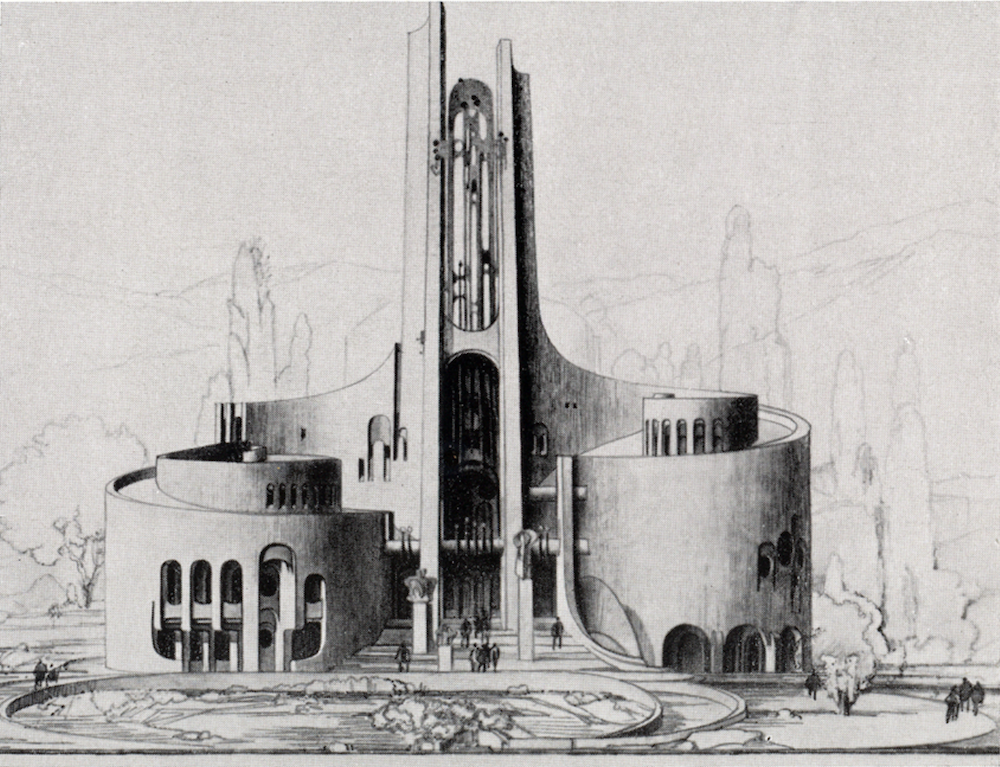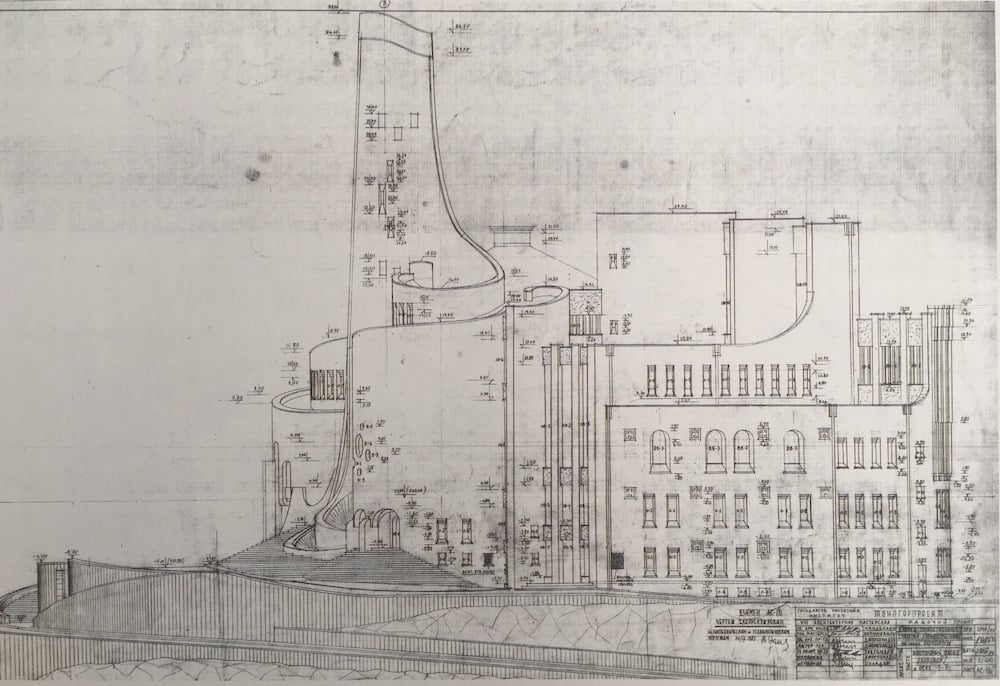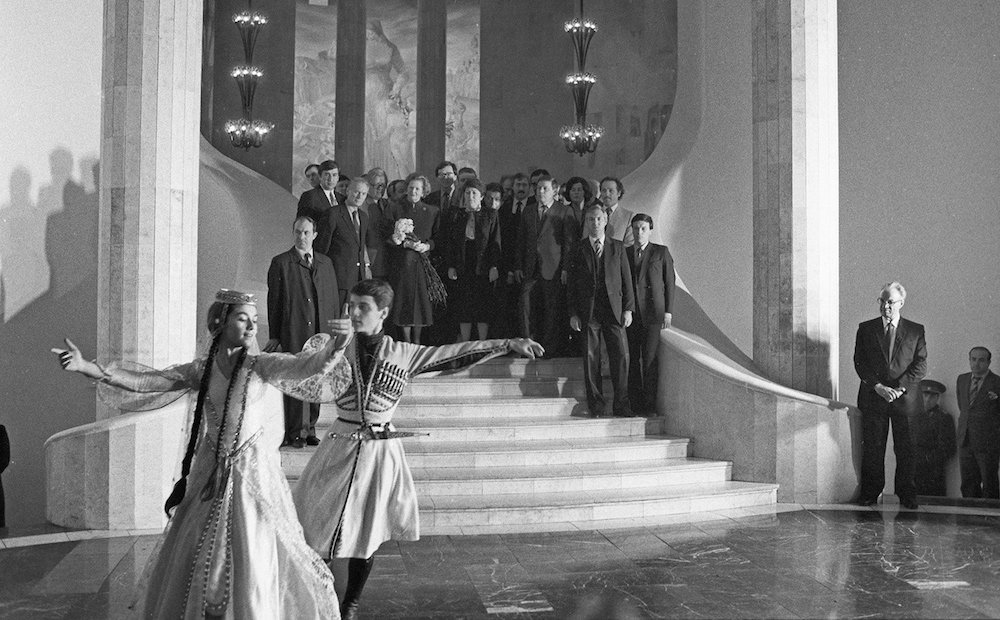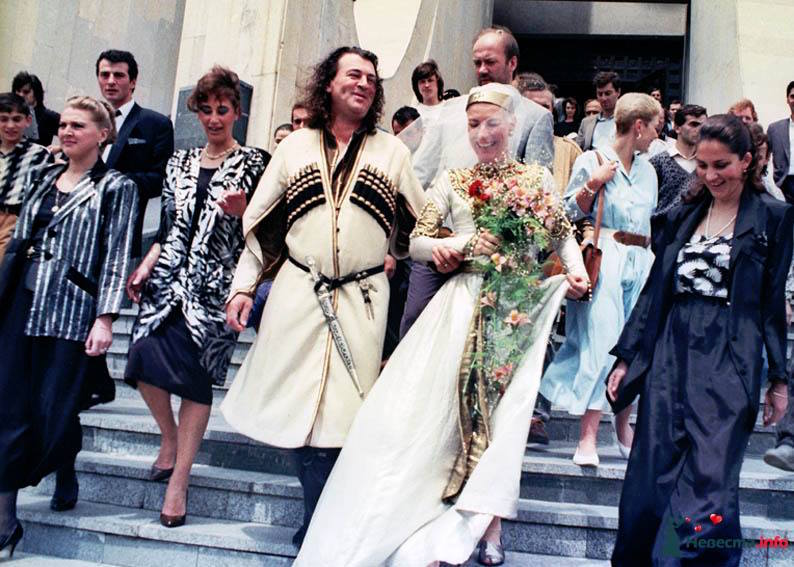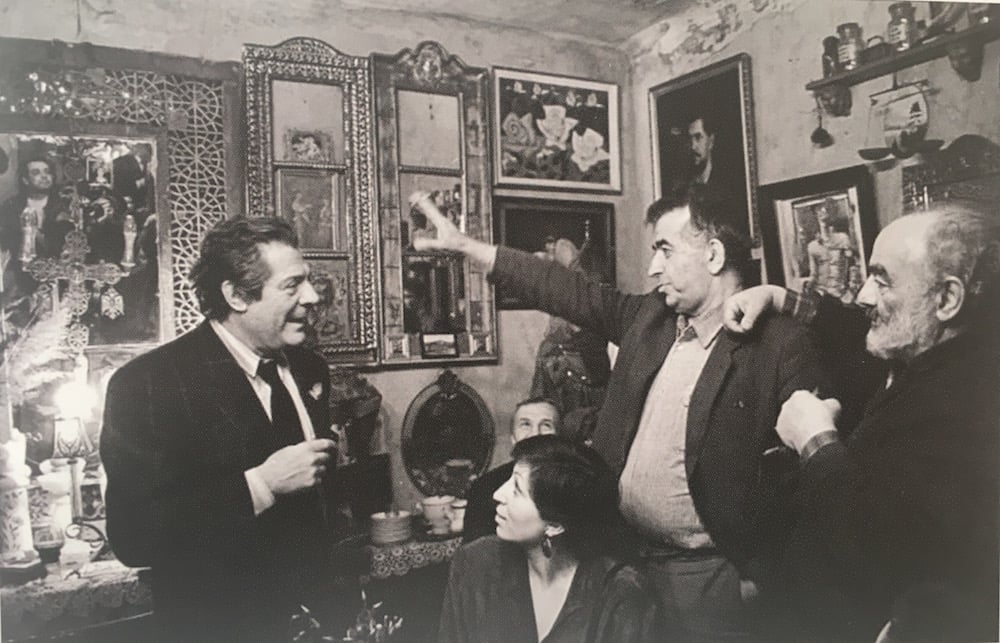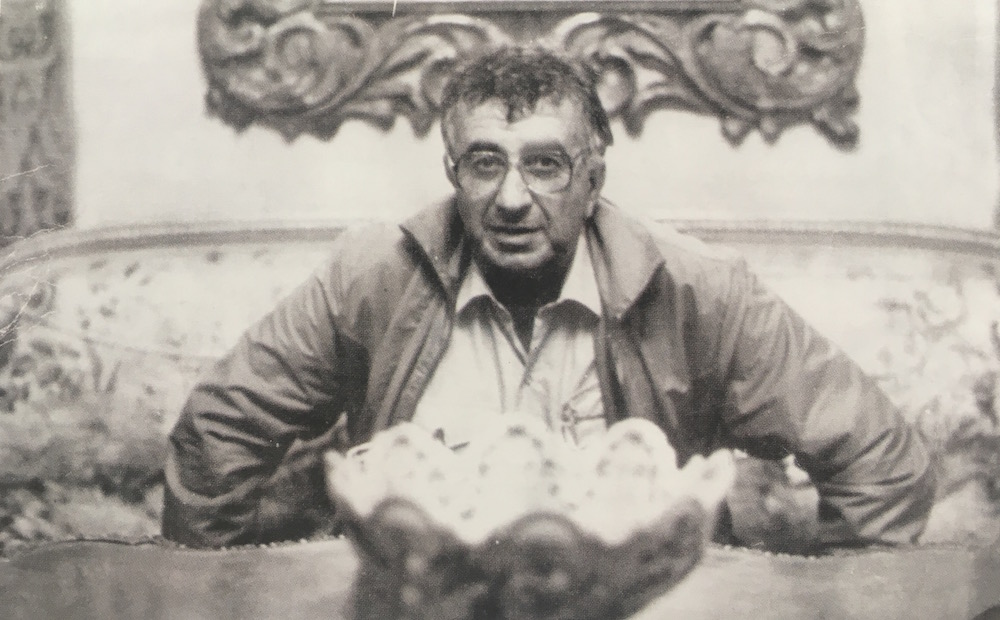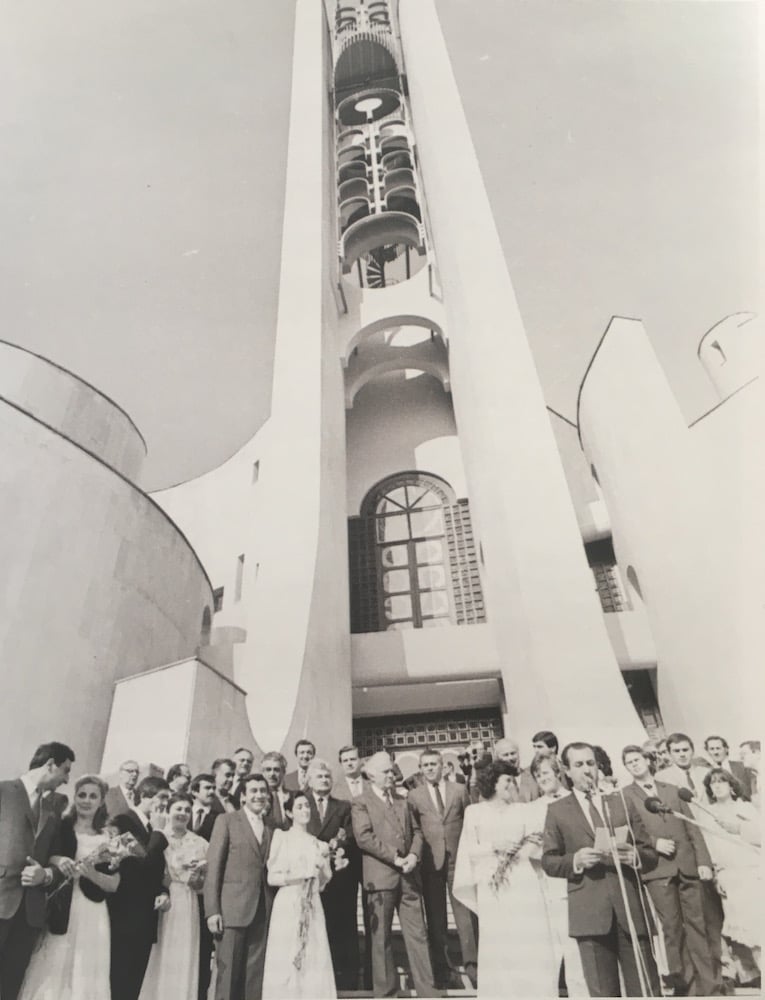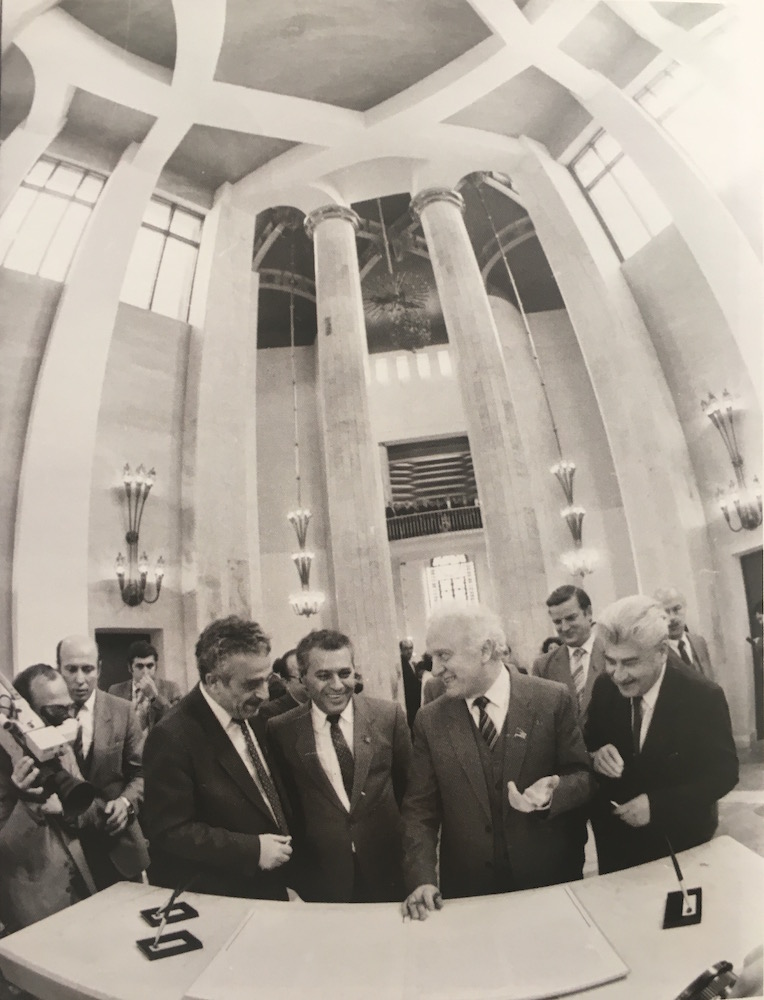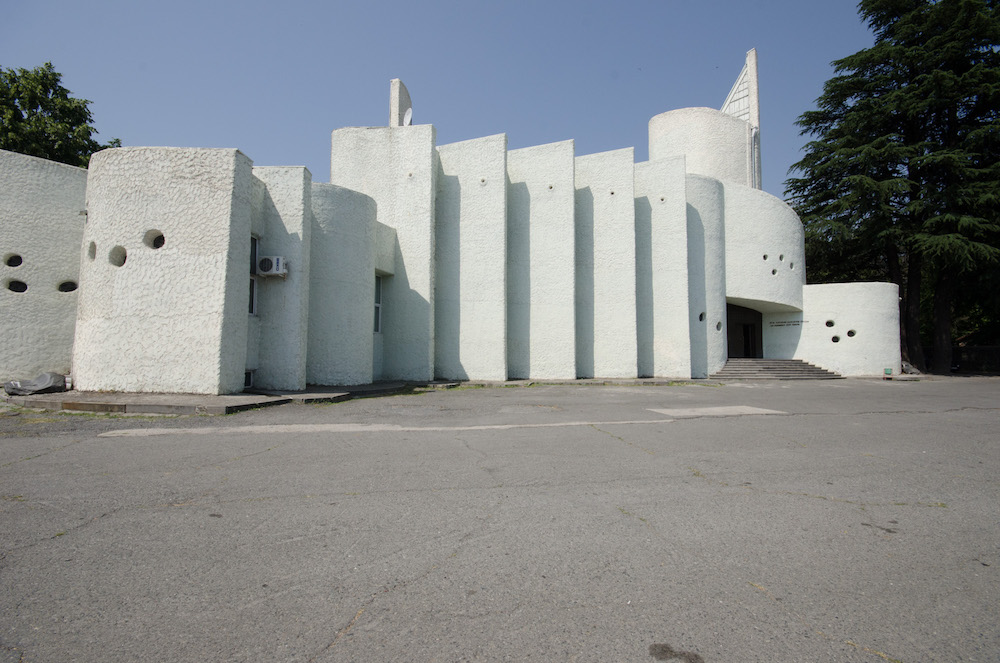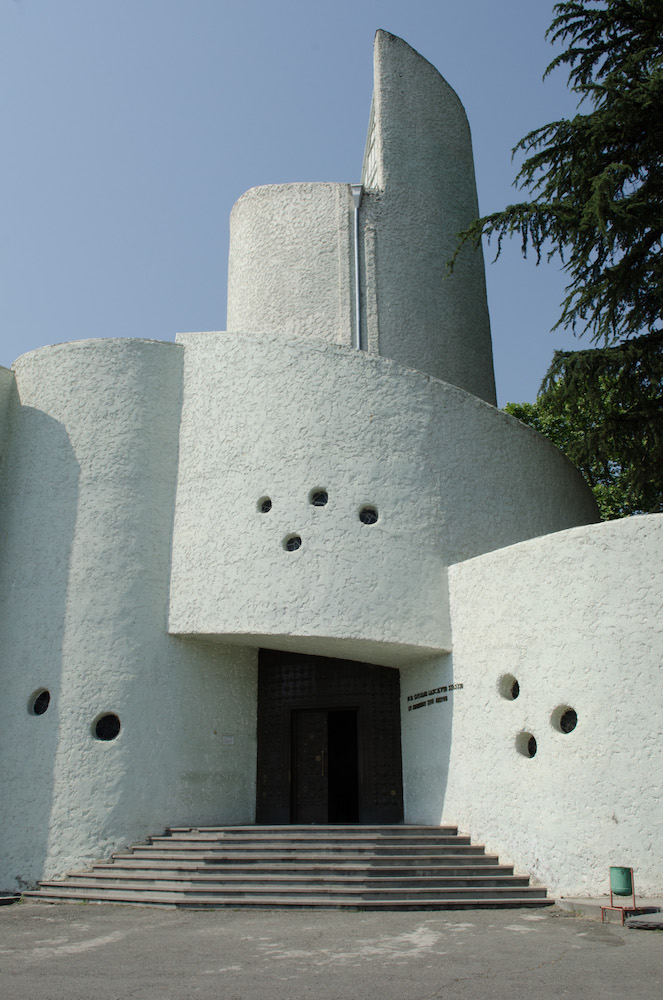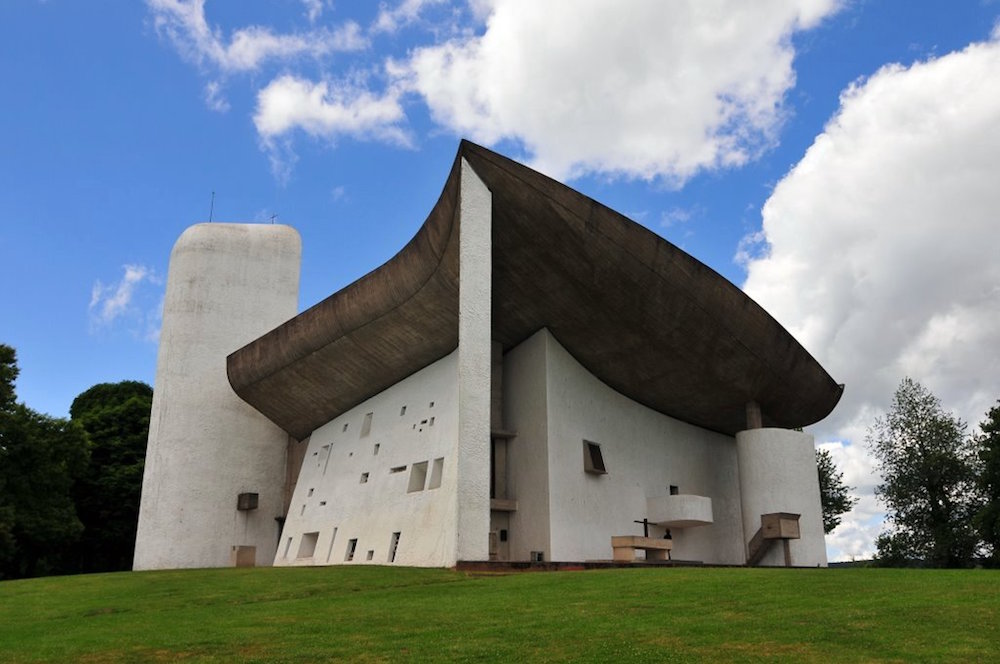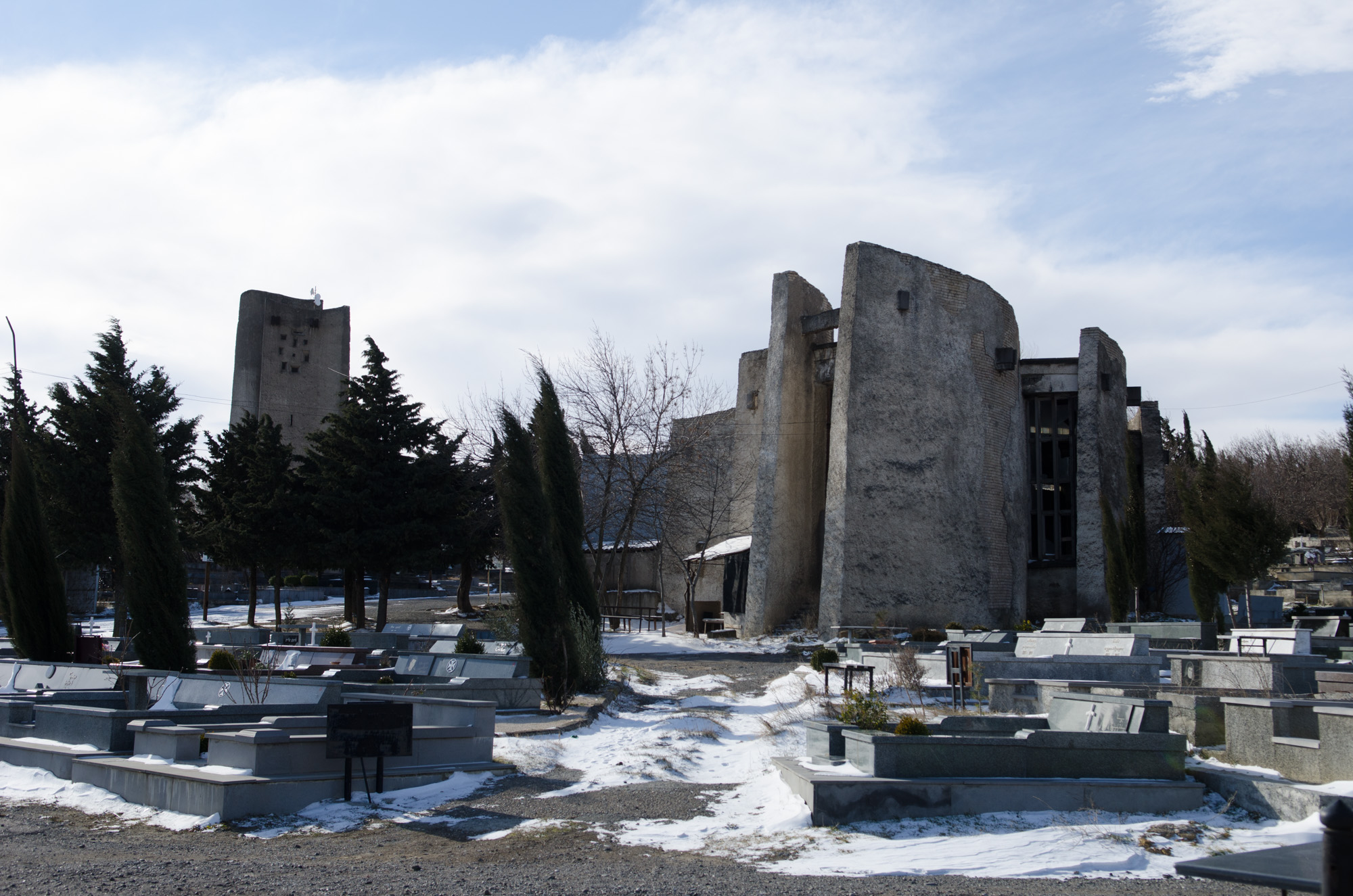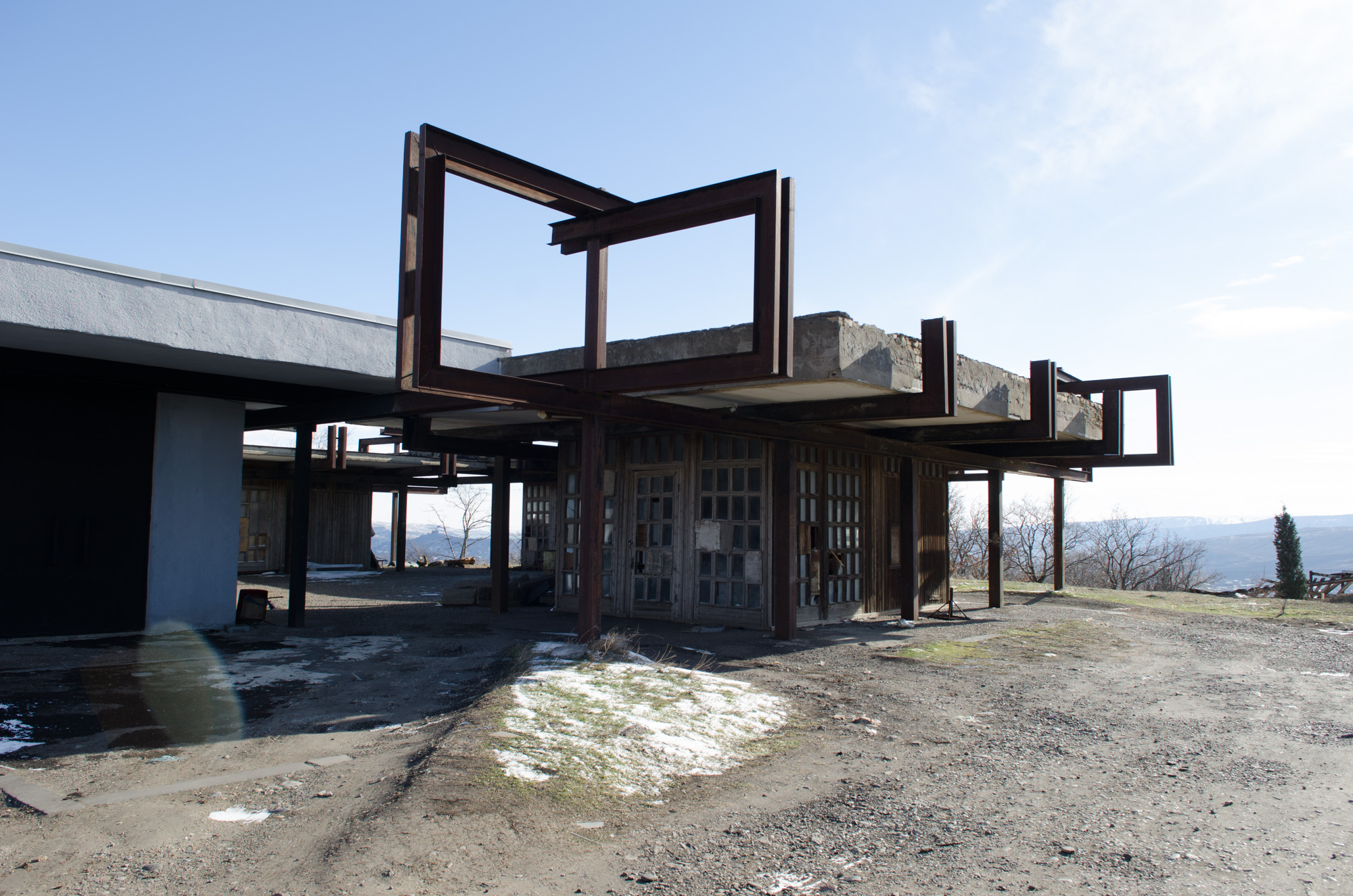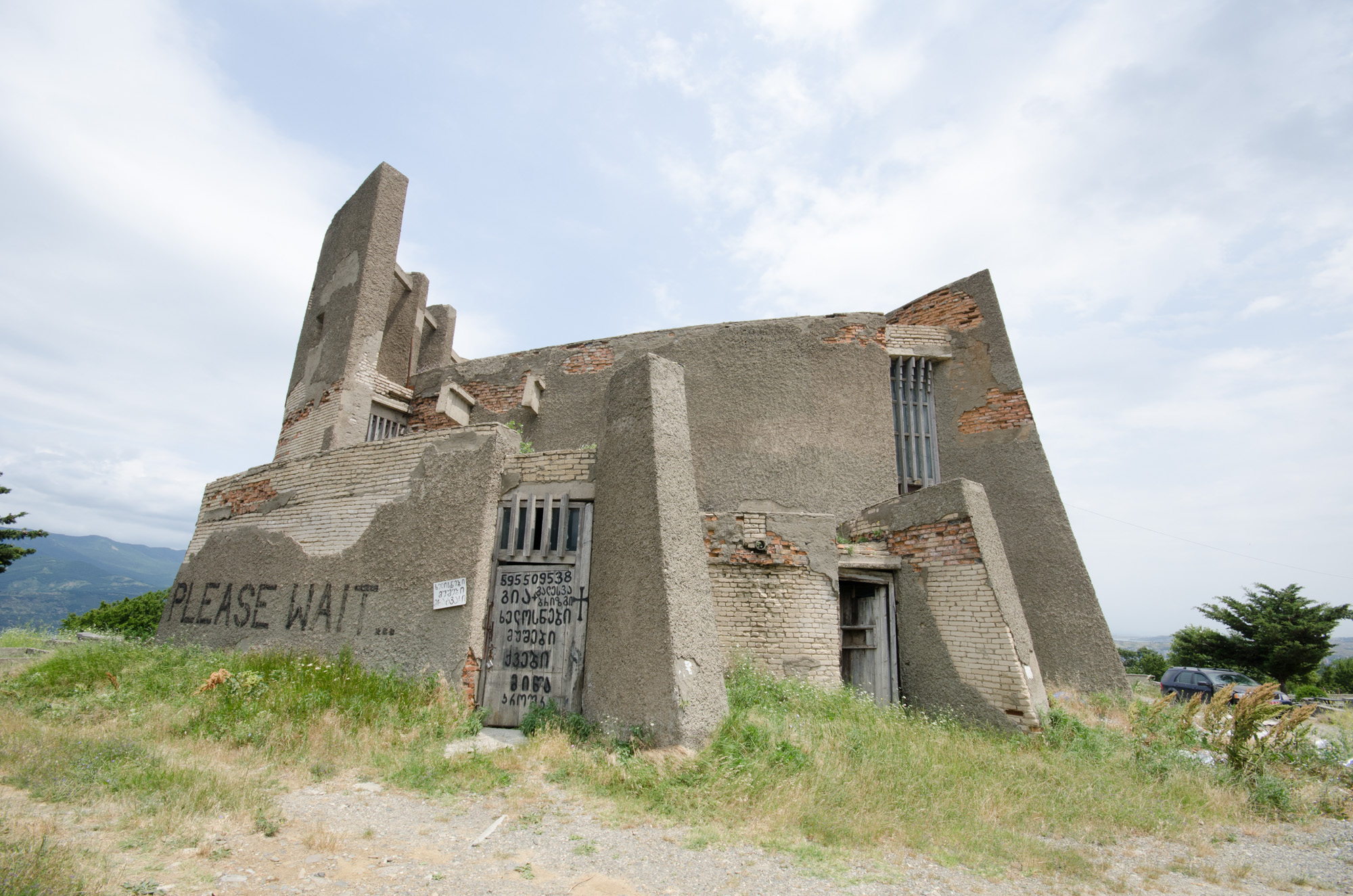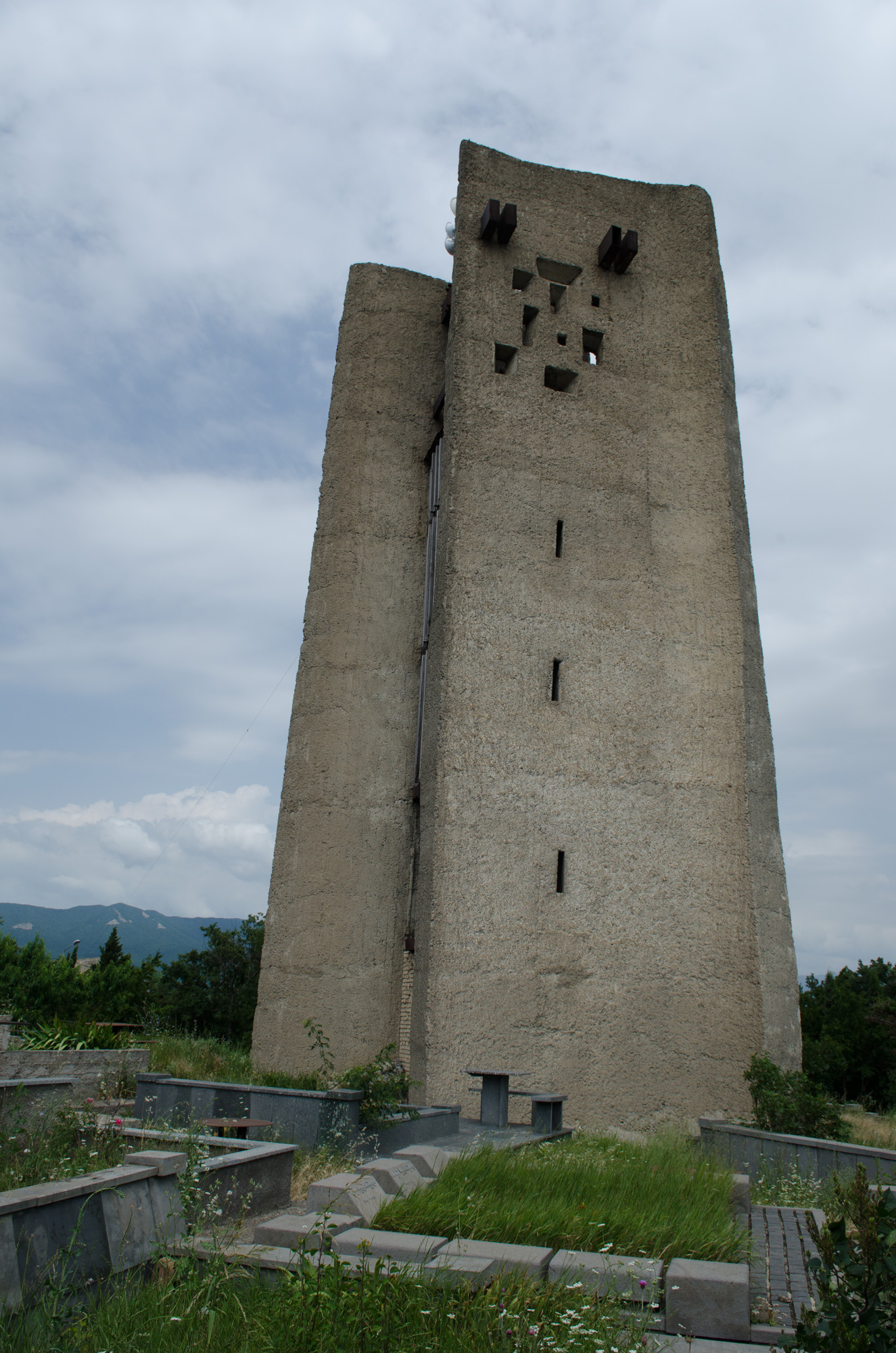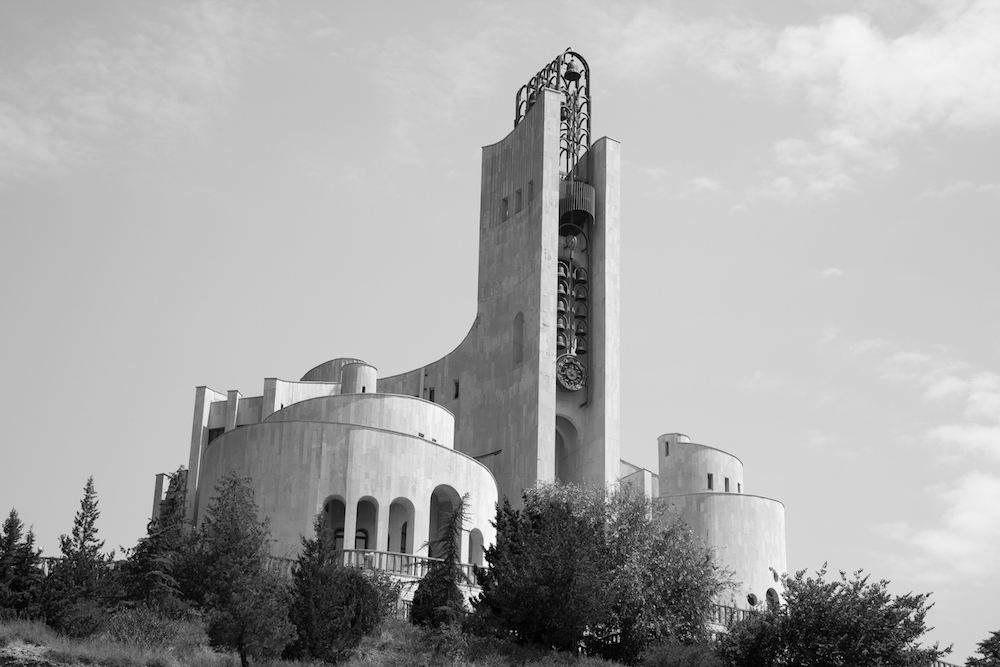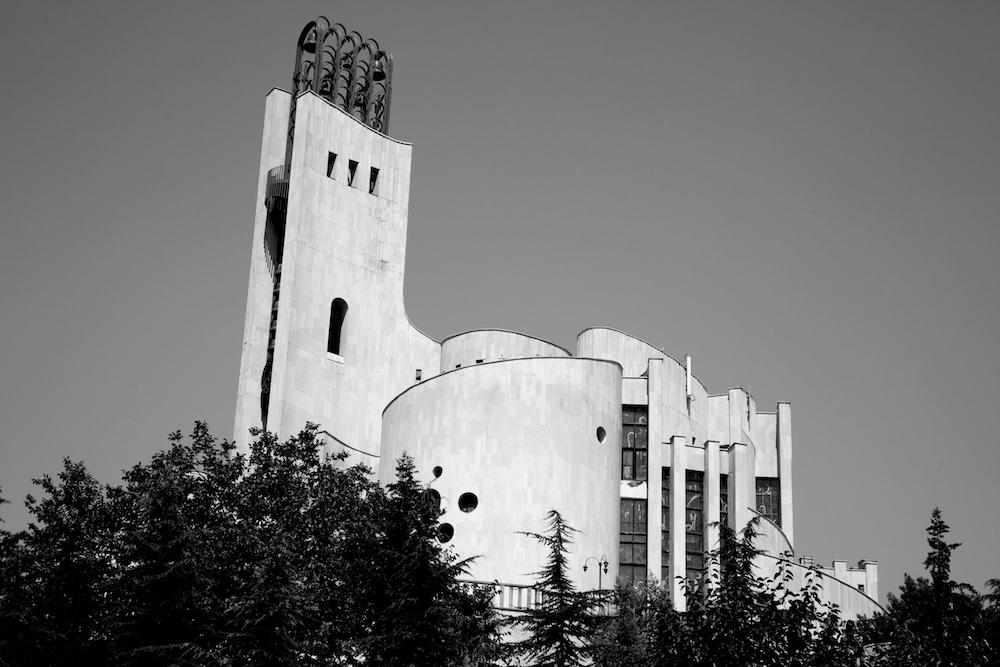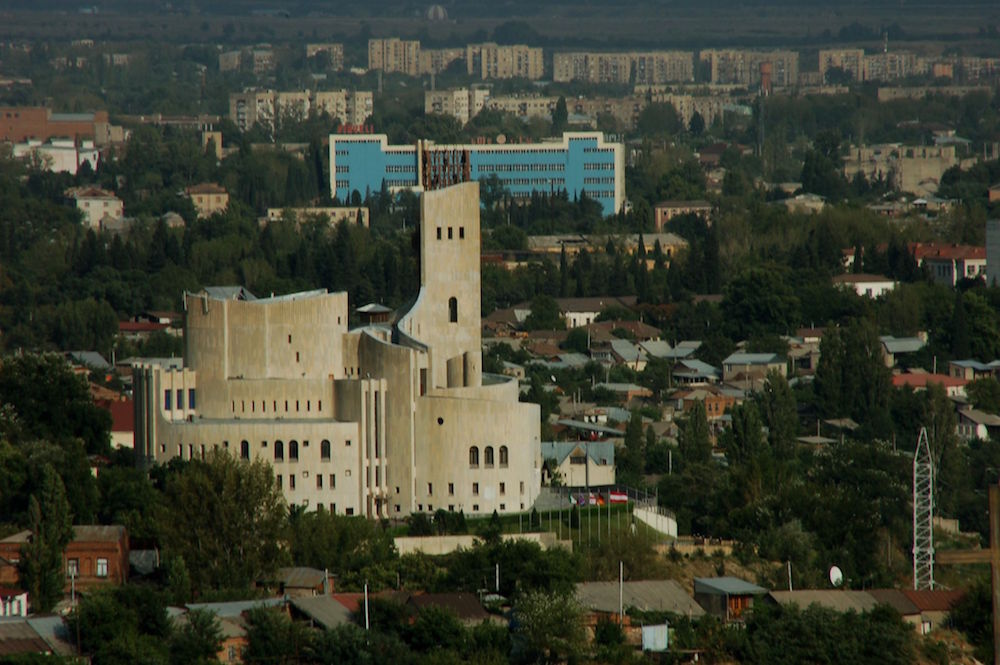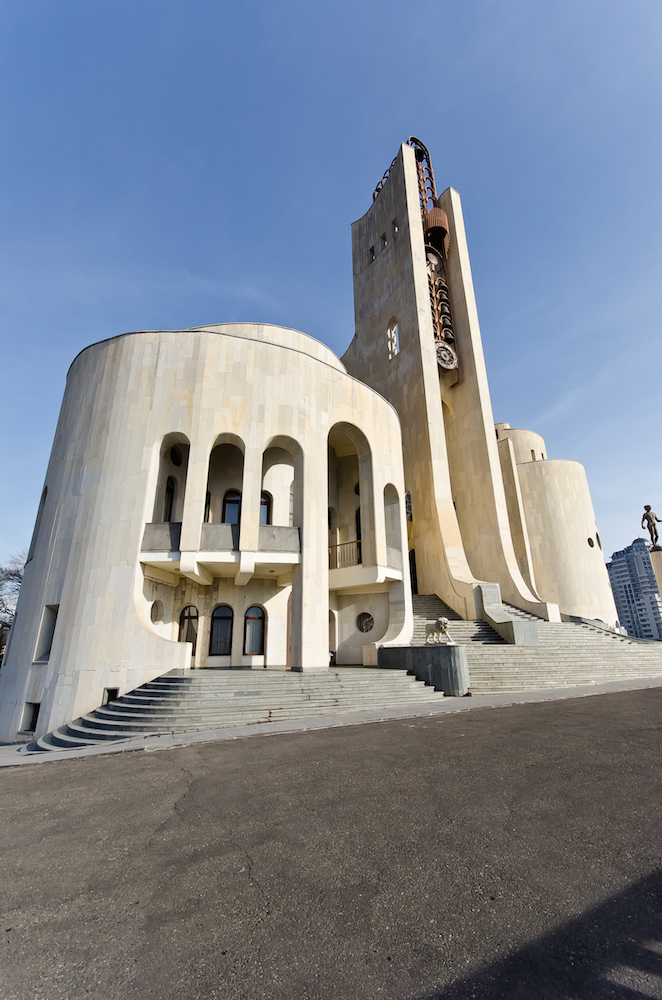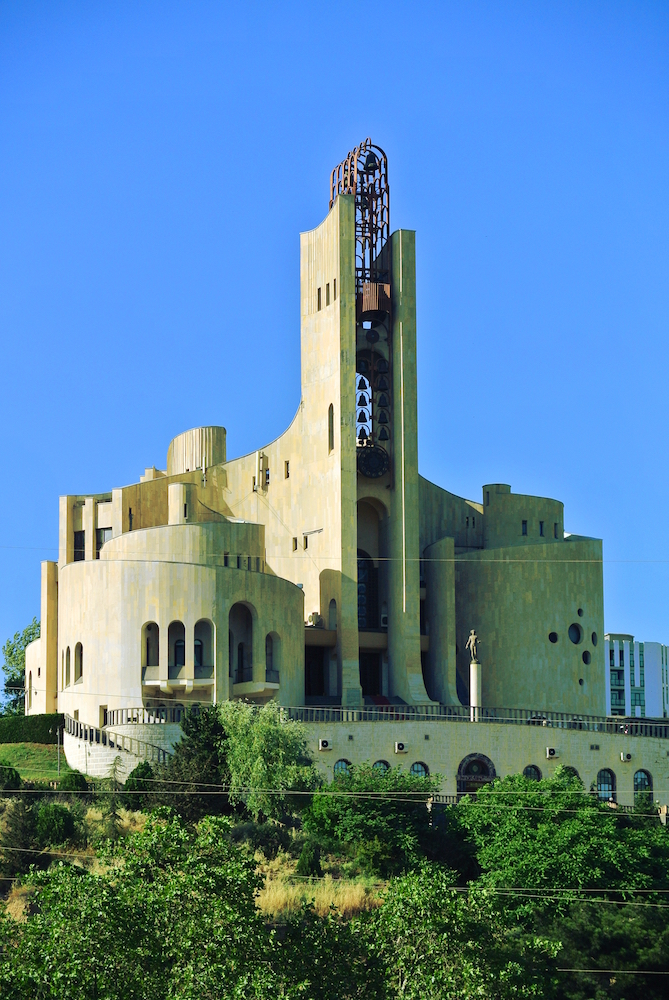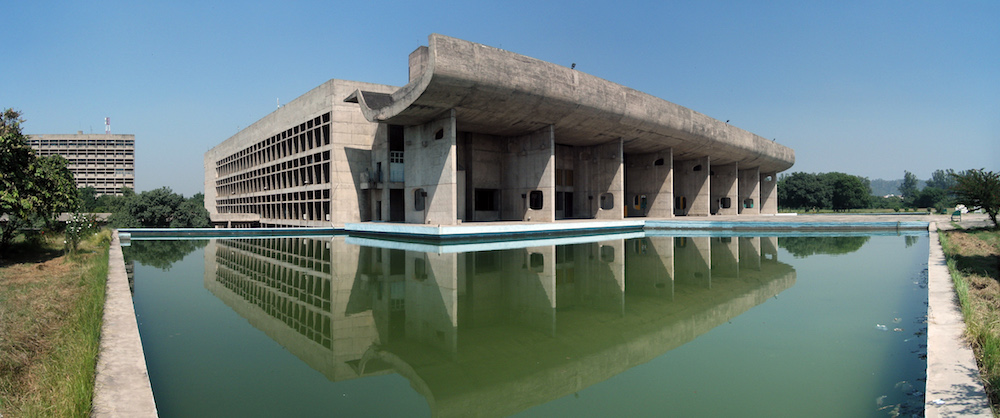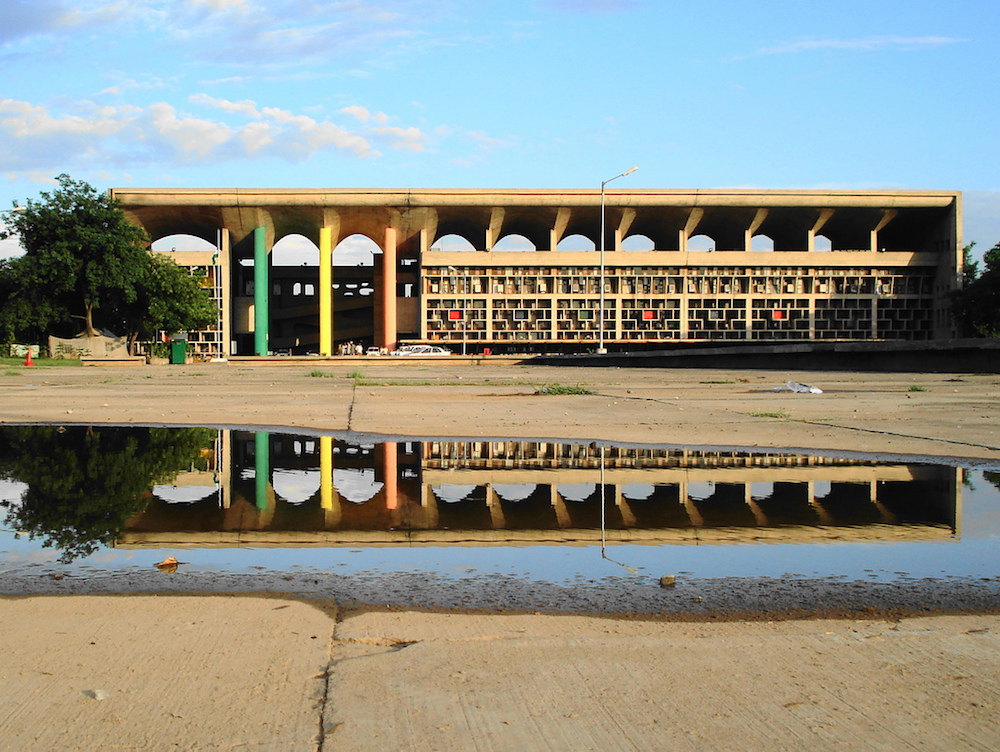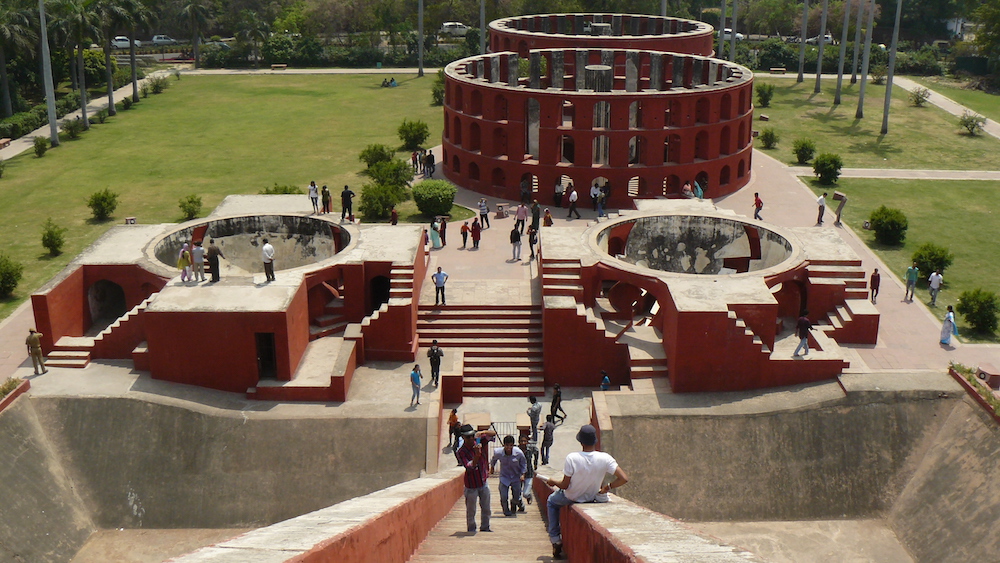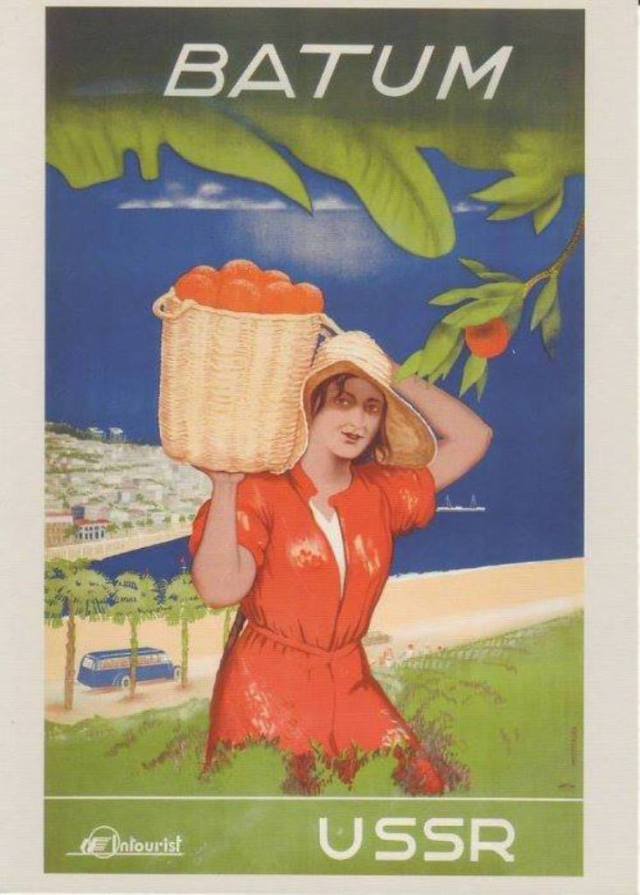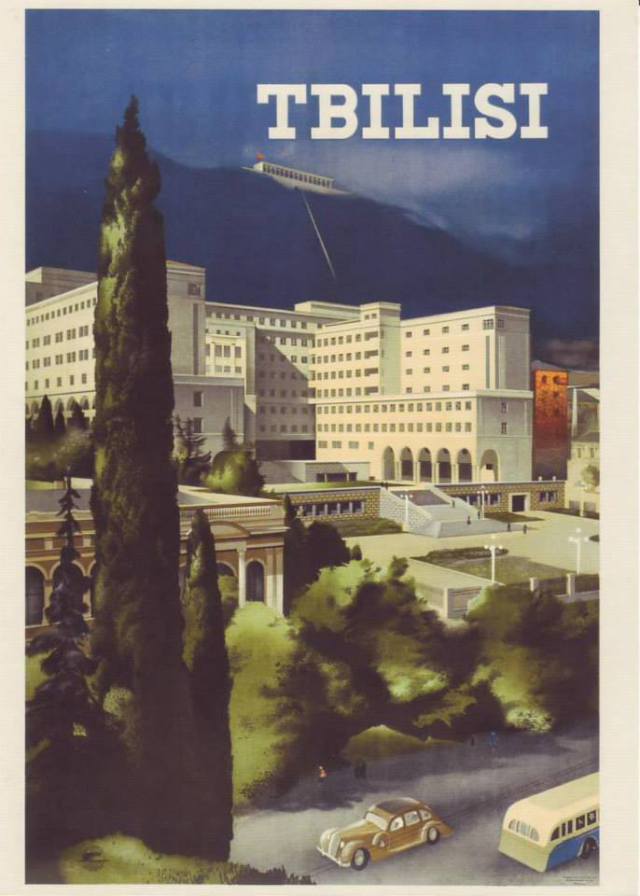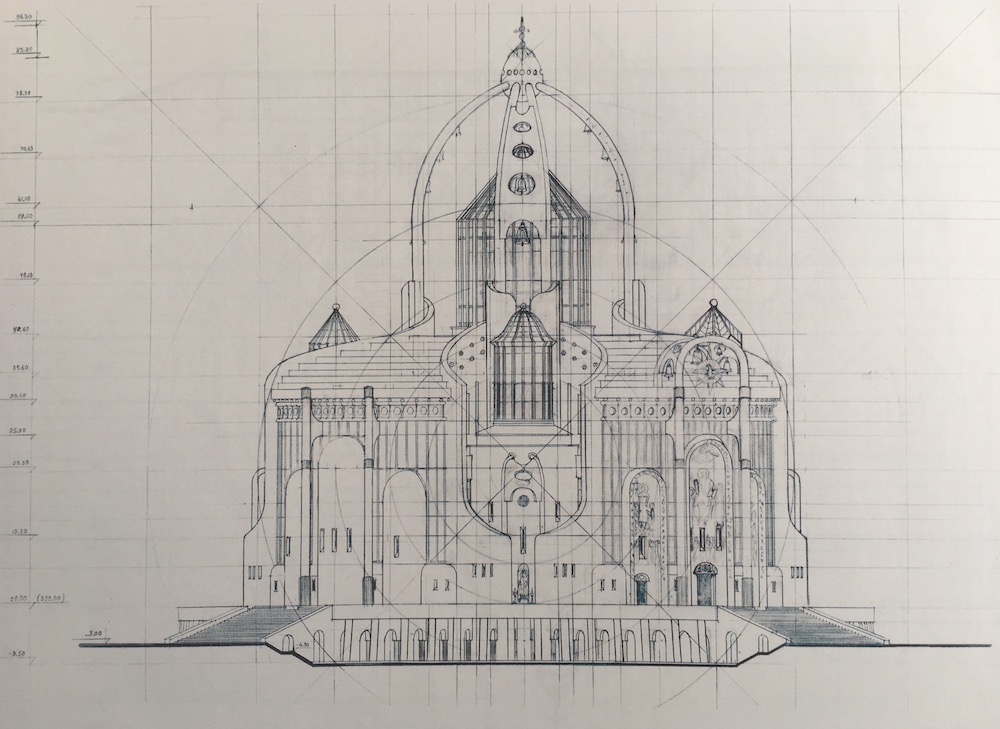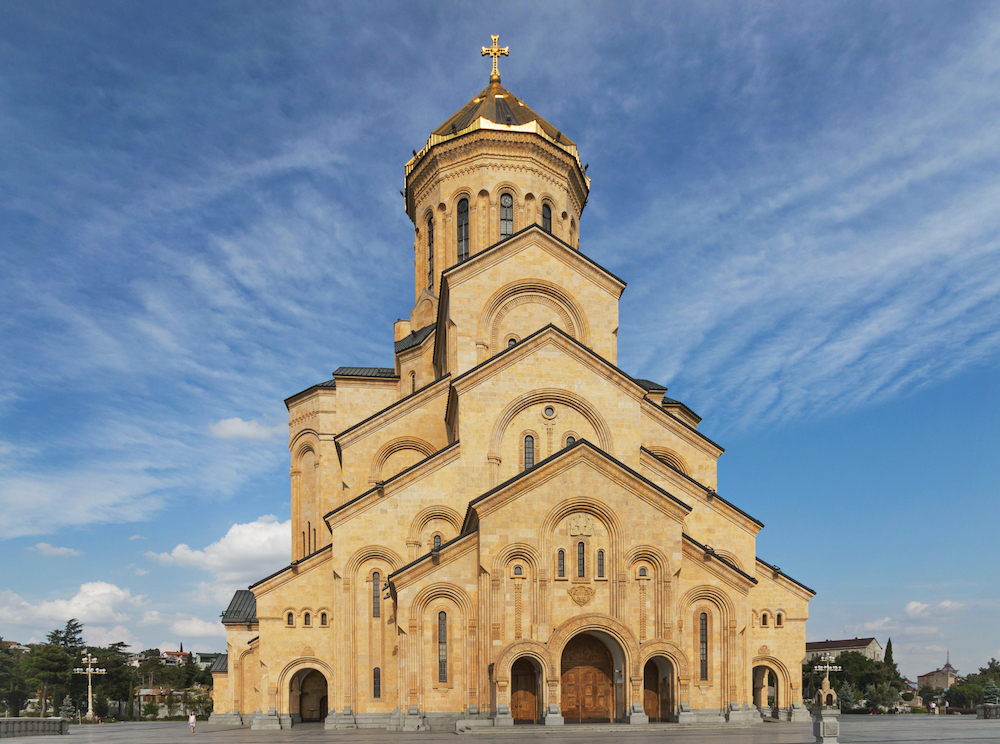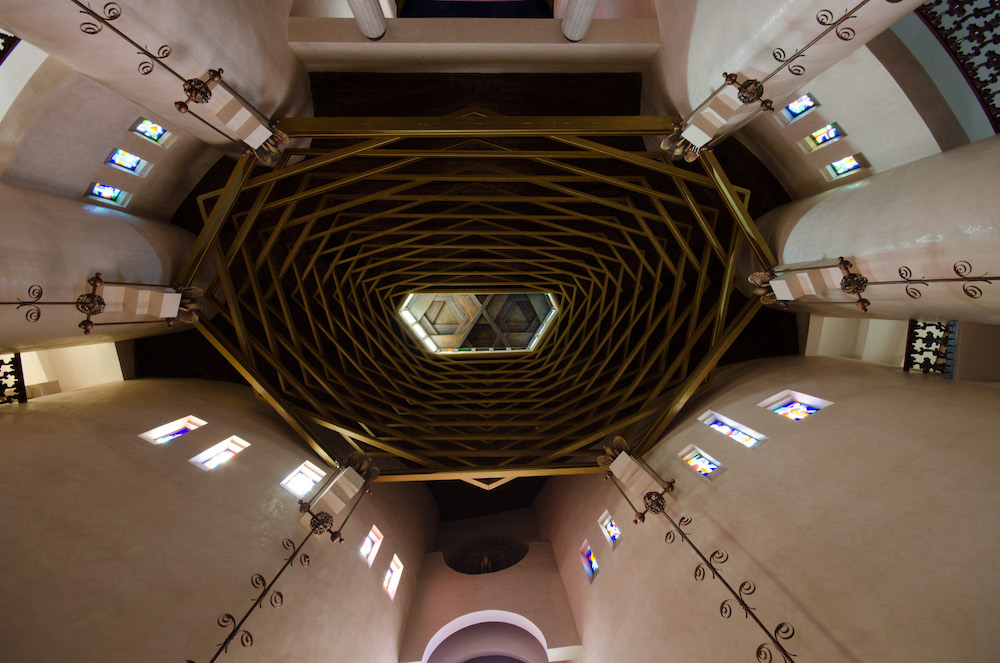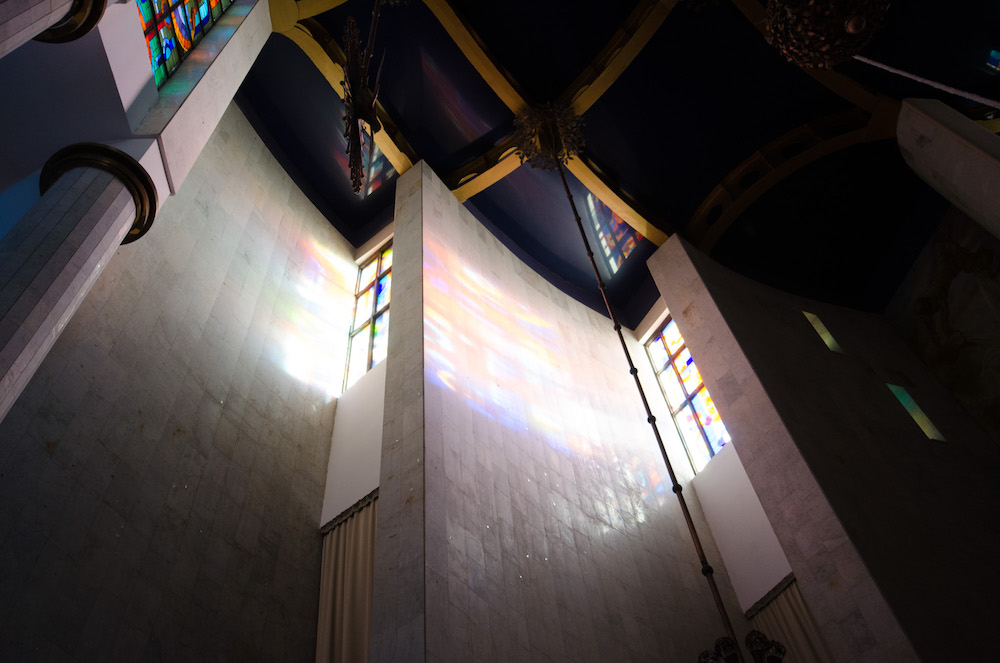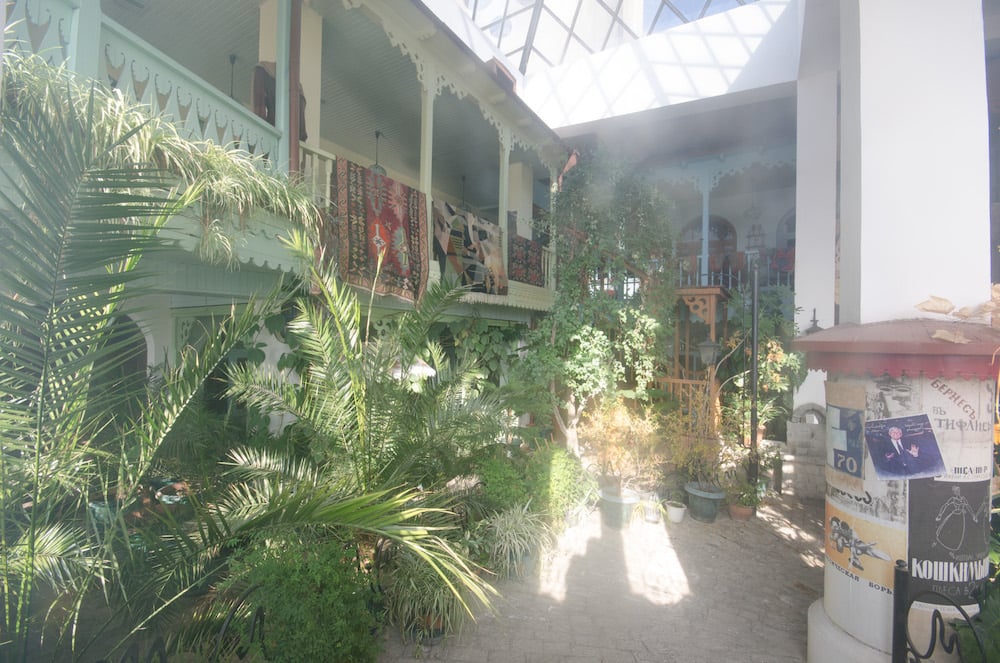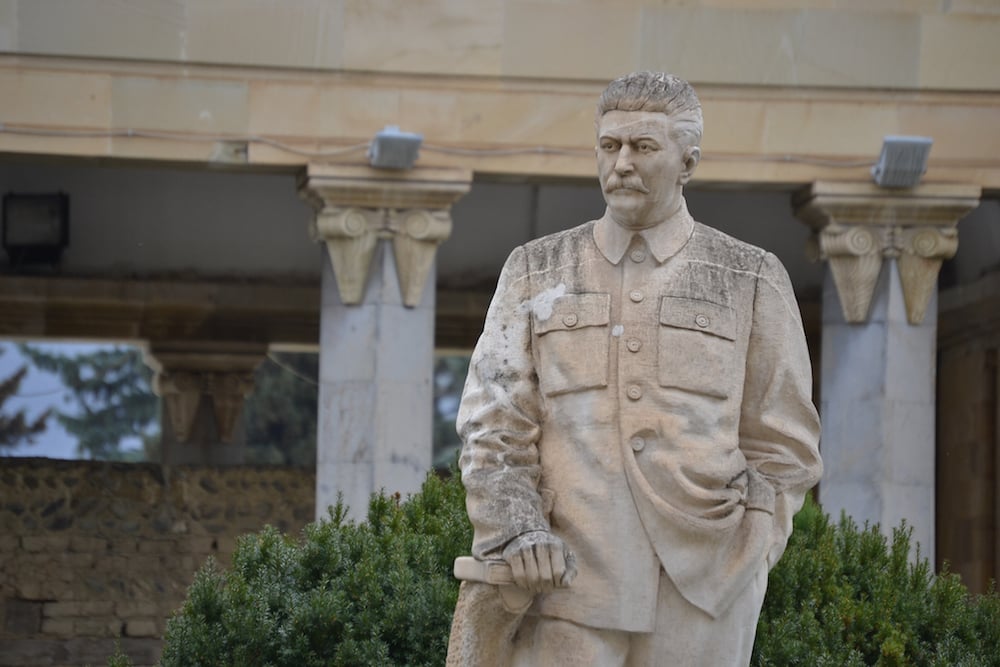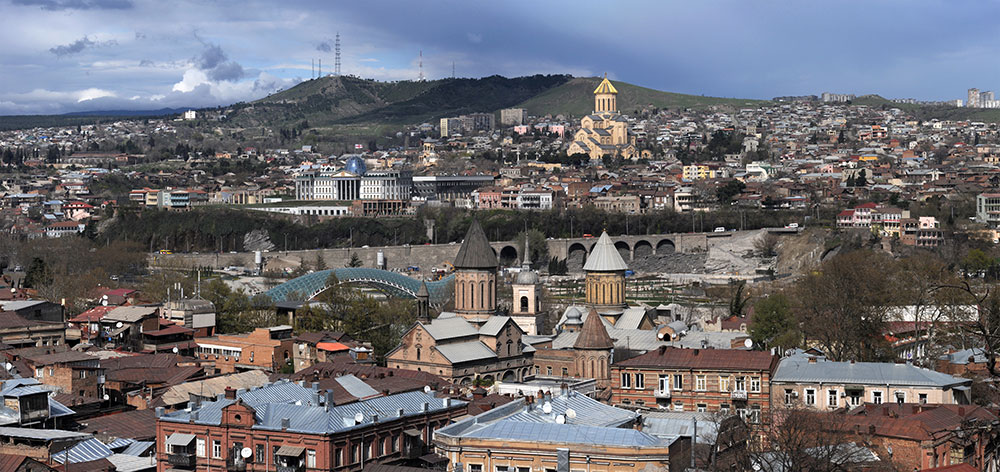Soviet po-mo: what can we learn from Georgia’s forgotten master architect?
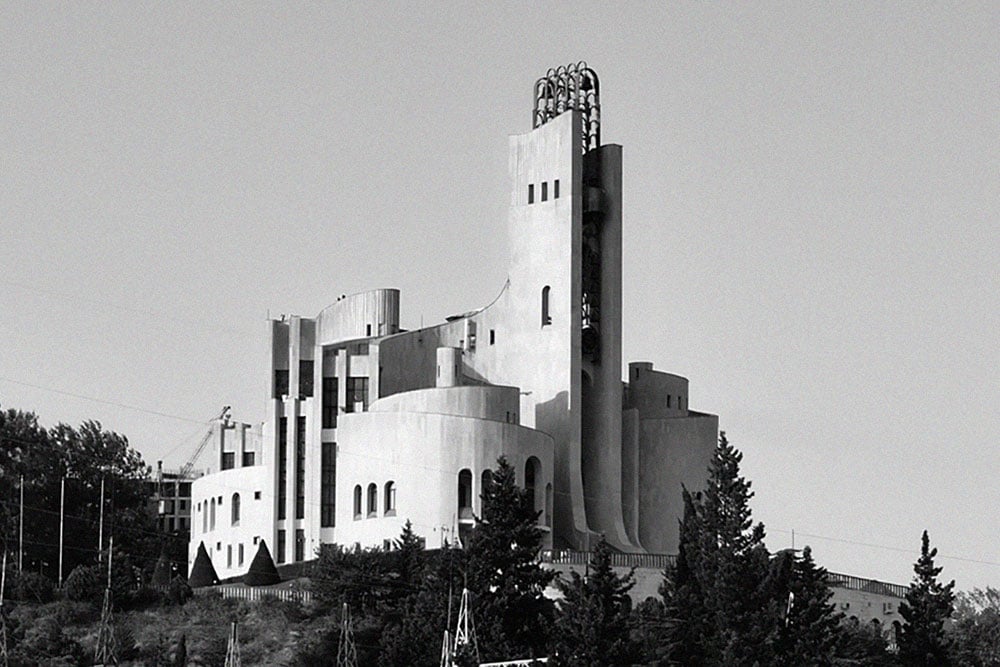
Best known for his Wedding Palace, a gloriously phallic edifice which stands erect on a hill above Tbilisi, Viktor Jorbenadze was an outlier among late Soviet architects. Angela Wheeler and William Dunbar celebrate the work of an unsung postmodernist hero
Rising from the banks of the Mtkvari River, the structure dominates the landscape like an enormous abstract sculpture. Its ritual function is unmistakable: it is the size of a cathedral and clad in the same warm stone used in Georgia’s medieval churches. It also happens to be exuberantly phallic — a giant cock and balls against Tbilisi’s ancient skyline.
The Palace of Rituals, or Wedding Palace as it is universally known, is the wrong building in the wrong place at the wrong time: a cathedral built in the atheist USSR, a Soviet celebration of Georgian national heritage, a cultural innovation in an era remembered largely for conformity. It is the work of Viktor Jorbenadze — nicknamed Jorbusier for his love of the French-Swiss master — an architect of genius whose daring and provocative buildings defy categorisation. Just like the now-forgotten moment that produced them.
Jorbenadze’s peculiar masterpiece shows the USSR and its modern architecture in a new light. Despite the chasm that separates the Brezhnev years from the modern West in terms of aesthetics, mores, and economics, Soviet architects in the seventies were as concerned with the problem of “placeless” architecture as any globalised city today. Behind the Iron Curtain, a parade of drab, mass-produced towers marched relentlessly from Vilnius to Vladivostok. It took someone like Jorbenadze to subvert this. His work is neither Old City quaint nor tower-and-slab modern. That it is neither of those things is what makes him special. He built big, but with an eye to what surrounded him — a kind of contextual monumentalism. His designs evoked local traditions without fetishising them, creating an alternate route between too precious and too placeless.
In the late seventies Georgia was by far the best place to live in the Soviet Union
What makes the bold experimentation of the Wedding Palace surprising is not only its design but its dates: commissioned in 1979 and finished in 1984. Across the Soviet Union this was the Era of Stagnation. The time of the gerontocracy, of ageing politburo members catching their deaths watching military parades, of tumbling living standards, drab fashions and stifling censorship. Except, that is, in Georgia. In the late seventies Georgia was rich — as rich as the capitalist countries of southern Europe. Flush with Moscow subsidies, a booming tourism sector and a massive black market, Georgia was by far the best place to live in the Soviet Union.
Crucially, Jorbenadze’s Georgia was — relatively — free. Far from the prying eyes of Moscow, and with an impenetrable language and a culture of individualism, it was a place you could get away with stuff, whether getting fabulously rich in the wine game or expressing your artistic visions on a grand scale.
In film, directors like Tengiz Abuladze produced startlingly subversive films like Repentance, in which the corpse of Stalinism is literally exhumed on screen; in music, seemingly innocuous ‘Vocal and Instrumental Ensembles’ mixed bootleg disco and funk with traditional folk music to startling effect — all funded with lashings of government money. But Jorbenadze’s architecture gave this contradictory era its most eloquent expression and its most tangible legacy.
Khrushchev’s thaw allowed artists and architects to delve into the past
Jorbenadze was a true child of the Georgian Soviet Socialist Republic, the arc of his life mirroring that of the Communist experiment. Born in 1925, just four years after the Bolsheviks had crushed the promise of the short-lived Democratic Republic of Georgia, he died in 1999, half-forgotten and overlooked in the wreckage of the post-Soviet transition.
He came of age in a country devastated by war, and in a social milieu that had been almost wiped out by Stalin’s purges — his circle was “the remnants of the intelligentsia,” according to his friend, the grande dame of Georgian film production, Manana Baratashvili. But it was quite the remnant nonetheless. Painters, actors, poets and philosophers, and above all, Jorbenadze’s lifelong friend the filmmaker Sergei Parajanov, who would go on to win international fame (his masterpiece, 1969’s The Colour of Pomegranates, owes some of its inspiration to a trip he and Jorbenadze took to Armenia to look at churches). Homosexuality, while illegal, was tolerated among this bohemian crowd. Free thinking, on the other hand, was not. Parajanov was openly gay, and both he and Jorbenadze were caught up in the downfall of a homosexual KGB officer in the late 1940s. Jorbenadze left Tbilisi, and may have been sentenced to a term in a mental institution before heading to architecture school in Moscow, while Parajanov served the first of many sentences for “immorality.”
After his apprenticeship in Moscow, Jorbenadze returned to Tbilisi in time for Khrushchev’s thaw in 1957. He used this window of liberalism to throw himself into international architecture, reading voraciously in French and German, and cultivating his passion for Le Corbusier. He was also able to travel, bringing ideas from Western Europe back with him across the Iron Curtain. He also visited India, where he demanded that his Soviet minders change the route so he could visit Corbusier’s Chandigarh — not for the last time, he got his way with the authorities.
As well as the international travel, the thaw allowed artists and architects to delve into the past and rediscover a traditional culture that had been forbidden since the revolution. Jorbenadze embraced Georgia’s extraordinary ecclesiastical heritage, and completed a survey of thousands of the country’s ancient churches. It was fluency in his homeland’s religious heritage that later allowed him to construct his new ritual architecture.
The spiralling, snow-white stucco building looks like it has descended from space
It wasn’t until the seventies that Jorbenadze would have the opportunity to put his ideas into practice. The man who gave him the chance was party boss Eduard Shevardnadze, who had been appointed as a new broom to clean out the Augean Stables of Georgian corruption in 1972. In his 40s, he was slip of a lad compared to the dinosaurs in Moscow. Shevardnadze was also clever and ambitious, and keen to turn his peripheral republic into a showcase of what “Developed Socialism” could offer. From high end arts and culture to big building projects, in large part, he succeeded.
It’s striking, and creditable, that a provincial party hack would take a chance on a cosmopolitan intellectual with openly gay friends — but Shevardnadze needed Tbilisi’s cultural elite on his side. According to Viktor’s friend and collaborator, the artist Zurab Nizharadze, “It was time for changes, and it was Shevardnadze who opened the door.” Almost unwittingly, Shevardnadze became one of the greatest patrons of the arts the Soviet Union ever produced.
Jorbenadze’s first solo project, Mukhatgverdi, was also his first experiment with ritual buildings: a hilltop ensemble for a vast new cemetery on the outskirts of Tbilisi, symbolically overlooking Jorbenadze’s favourite ancient churches. The four buildings — a cemetery office, water tower, carving workshop, and ritual hall — display both his potential and his great debt to Le Corbusier. But to build Mukhatgverdi, Jorbenadze took a different approach than simply copying his idol brick-by-brick, experimenting with the fusion of Georgian tradition and Corbusian design that would later come to fruition in the Wedding Palace. Jorbenadze intended each building to represent a different aspect of Le Corbusier’s 1954 Chapel of Notre Dame du Haut, but also embedded medieval Georgian tombstones in the textured stucco.
While completing the cemetery in 1974, Jorbenadze was immediately awarded another commission for a house museum extension dedicated to Ilia Chavchavadze, a 19th century man of letters and national hero. Jorbenadze pushed for a freestanding museum, hoping both to preserve Chavchavadze’s historic birthplace and to fully realize his creative ambitions. In the provincial town of Kvareli, the spiralling, snow-white stucco building looks like it has descended from space.
Our own historical moment could use a little of the Jorbusier approach
Relative intellectual freedom had allowed Jorbenadze to look outward to modernists like Corbusier, but also inward to Georgia’s history. He would fuse these two currents into a unique, Soviet Georgian postmodernism in the Wedding Palace.
It was Shevardnadze who gave the go-ahead for the project, bankrolling and backing it all the way. He wanted an architectural grand projet to complement his recently invented holiday of Tbilisoba — a Sovietised harvest festival. Much in the same way Tbilisoba was aimed at discouraging attendance at traditional or religious seasonal festivals, the Wedding Palace would offer Soviet Georgians grandeur and ritual with no need for the superstitious, anti-Communist trappings of a church. Wedding Palaces had been around since the late fifties, and were increasingly constructed as freestanding, lavish affairs. Nowhere else, though, would they be on such a scale.
The sheer size and cost of Jorbenadze’s project caused a scandal, as did his insistence upon referring to it as a cathedral. Shevardnadze, determined to get his way, was forced to step in and remind critics that “people do like churches.” No expense was spared on the building, which features hand-made stained glass and decorative ironwork, and even manhole covers stamped with its image. Its interior is swathed in frescoes by Zura Nizharadze, which cheekily evoke the ecclesiastical — one of them shows a lion-headed Jorbenadze holding the Wedding Palace in the palm of his hand, just like medieval patrons are depicted in the frescoes of the churches they commissioned. The form of the palace itself was more secular, but still suggestive — just as it united Soviet men and women in matrimony, the hermaphroditic building united an unblushingly phallic exterior with a uterine floor plan. The interior space is based around the female reproductive system (Jorbenadze’s mother was a gynaecologist): seen from above, the main entrance is the vagina, the side chapels are ovaries, and man and woman are united as a new family, destined to create new life, in the ceremonial space of the ‘womb’ which contains the altar. Again, this is the sort of way-out thinking more familiar in California than the Caucasus.
It was completed in time for Tbilisoba 1984, a year better remembered for the stern rule of Yuri Andropov. As the finishing touches were applied, Jorbenadze told his friend, visiting American mathematician Rolf Gross, that the Soviet Union would collapse within a decade — a prediction that seemed absurd in High Soviet Tbilisi.
For Shevardnadze, the building served its purpose well. It stood as a symbol of the developed, modern socialist republic he wanted Georgia to be, and it soon became a stop on the itinerary of foreign dignitaries in Tbilisi: Margaret Thatcher visited in 1986 and, bizarrely, it hosted the wedding of Deep Purple frontman Ian Gillan in 1990. Shevardnadze’s tenure as party boss had been distinguished by the successful delivery of such prestige projects, and that, coupled with his reputation for modern thinking, led to his promotion to the politburo by Mikhail Gorbachev. As the USSR’s foreign minister, he was soon busy unravelling the Soviet empire and bringing Jorbenadze’s prediction ever closer.
But Moscow’s gain was Tbilisi’s loss. Between the departure of his patron and the subsequent chaos of the Soviet collapse, Jorbenadze would never complete another building. When the resurgent Orthodox Church announced a competition for a new national cathedral, Jorbenadze leapt at the opportunity to propose an extraordinary piece of ritual design: a “Cathedral of All the Faiths” that would synthesize decades of research on Georgian ecclesiastical architecture. Its modern materials and idioms symbolized a resurrected Church (and people) ready to face the future.
But the Georgian Orthodox Church was interested only in the past. An illiterate pastiche of Georgian medievalism, blown up to skyscraper proportions, was selected over the thoughtful fusion of old and new. Ironically, Jorbenadze was able to get a “cathedral” approved by Soviet authorities — but not by the Church.
As post-Soviet chaos engulfed the country, the rejected architect retreated into his antique collection. Both Jorbenadze and the possibilities of his architecture were buried in 1999 at Mukhatgverdi, the cemetery of his own design. The Wedding Palace, an unloved reminder of a discredited regime, stood utterly redundant in the muscular Christian environment of the new Georgia.
And so it might have remained, crumbling and vandalised, had it not been for the curious whim of hometown oligarch Badri Patarkatsishvili and the billions he amassed in the gangster’s paradise of 1990s Moscow. Shevardnadze — now president of war-torn, impoverished Georgia — was only too happy to offload the crowning architectural achievement of his previous tenure for use as Badri’s private residence. In a case of inadvertent preservation, Patarkatsishvili left the soaring ceremonial hall intact, preferring instead to occupy a fanciful Old Tbilisi courtyard reproduction he commissioned for the basement. This rec room historic district embodies the taste for sanitised historical confections that has become increasingly common in ex-Communist cities.
Jorbenadze’s work is now a forgotten alternative to both mindless repetitions of the past and the knockoff starchitecture of the present. If he is remembered at all it is as a Soviet architect, even if his creative drive aimed at creating a new Georgian architecture. Today, Tbilisi’s rapacious real estate industry is as indifferent to local needs and history as any mass housing policies handed down from Moscow forty years ago. Much the same might be said, however, of any city where the moneyed park their gains in glass boxes or fabricate Potemkin stage sets of imagined heritage. Our own historical moment could use a little of the Jorbusier approach that innovates without lapsing into imitation and honours tradition without indulging in sentimentality — all animated by a joyous, slightly mad approach to architecture and ritual.
Badri Patarkatsishvili unexpectedly died in 2008, leaving the Wedding Palace’s future uncertain once more. In 2012, his heirs did the decent thing, and opened the building to the public again, allowing future generations of Georgians (and heavy metal singers) to celebrate their unions in one of the most remarkable buildings of the last forty years. You can book your special day here.
